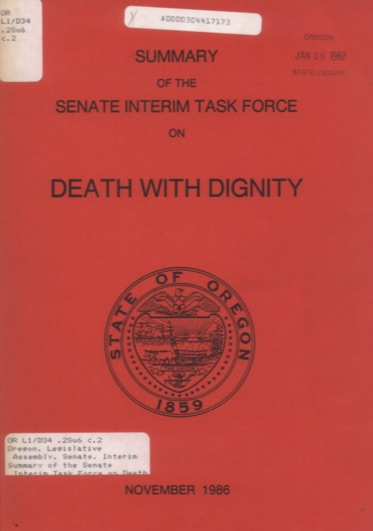In 1994, Oregon voters were the first in the nation to approve an act that allows a physician to prescribe a lethal dose of medication to a terminally ill patient for the purpose of self-administration. This practice is called physician-assisted suicide, physician-assisted death, or physician aid-in-dying.
Eligible patients must be adult residents of Oregon whom two physicians determine are able to make and communicate about their own health-care decisions. They also must have a life expectancy of six months or less and are not influenced in their decision by depression or another mental disorder. Patients must make two oral and one written requests separated by fifteen days, and they must be advised of the availability of comfort care and hospice (a program that provides care for people who are near the end of life). The law prohibits death by lethal injection.
The Death with Dignity Act became law in Oregon through a voter initiative that was passed by a slim majority of 51 percent. Implementation was delayed by federal injunction until 1997. That same year, in a second statewide ballot, 60 percent of Oregon voters reaffirmed their support for the law. Over the next decade, the Department of Justice and the U.S. Congress mounted unsuccessful challenges to the law that were ultimately decided in 2006 by the U.S. Supreme Court in Gonzales v. Oregon.
The law requires all prescribing physicians to submit information about patients who request assistance, which the Oregon Department of Human Services publishes yearly. Between 1998 and 2010, 525 patients died by lethal prescription—usually a high dose of a short-acting barbiturate. In the first decade of the law, the median age of decedents was 70 years; 54 percent were men, 82 percent were terminally ill with cancer, and 86 percent were enrolled in home hospice.
Most Oregonians who have chosen physician-assisted death have a higher-than-average educational attainment, are somewhat younger than other Oregon decedents, and are more likely to be divorced or never married. Only one in ten patients who request a lethal prescription actually die by this method. Barriers include the inability to find a physician willing to write the prescription, or not meeting the legal requirements, and some die during the fifteen-day waiting period. About two in every thousand deaths in Oregon are hastened through this law.
Efforts to legalize physician-assisted death resulted in a vigorous national debate about the ethics and social effects of such laws. Groups who supported the law argued for respect for individual autonomy and compassion for suffering among terminally ill individuals. Groups who opposed the law expressed concerns that it would disproportionately fall on vulnerable patients who were socially disadvantaged, lacked access to good end-of-life care, felt themselves a social or financial burden to others, or had treatable disorders such as pain or depression. Other opponents feared that the law would be a slippery slope leading to legalization of voluntary active euthanasia (in which an individual requests hastened death and the health care provider administers the lethal medication, usually by injection) and then to nonvoluntary or involuntary active euthanasia (an individual who does not request hastened death dies by lethal injection from a health care provider). Finally, some opponents argued that, irrespective of social concerns, it was unethical either for a person to take his or her own life or for a physician to assist.
Studies of requesting Oregonians, their family members, and their health care providers make it clear that individuals pursue physician-assisted death to maintain a sense of dignity and control, to avoid dependence on others, and to guarantee that they die at home. Patients are rarely motivated by financial concerns, inadequate social support, or pain and other physical symptoms experienced at the time of the request, though they are often worried about future pain. Although many requesting patients worry that they are a burden to their families, interviews with family members and hospice nurses do not indicate that families feel burden. There is evidence, however, that some Oregonians who died by physician-assisted death had untreated depression.
-
![]()
Summary of the Senate Interim Task Force on Death with Dignity, 1986.
Courtesy State Library of Oregon
Map This on the Oregon History WayFinder
The Oregon History Wayfinder is an interactive map that identifies significant places, people, and events in Oregon history.
Further Reading
Foley, Kathleen and Herbert Hendin, eds. The Case Against Assisted Suicide: For the Right to End-of-Life Care. Baltimore: Johns Hopkins University Press, 2002.
Ganzini, L., E.R. Goy, and S. K. Dobscha. "Why Oregon Patients Request Assisted Death: Family Members' Views." Journal of General Internal Medicine 23 (Feb. 23, 2008), 154-157.
Ganzini, L., E.R. Goy, and S.K. Dobscha. "Oregonians' Reasons for Requesting Physician Aid in Dying." Archives of Internal Medicine 169 (March 9, 2009), 489-492.
Ganzini, L., H.D. Nelson, T.A. Schmidt, D.F. Kraemer, M.A. Delorit, and M.A. Lee. "Physicians' Experiences with the Oregon Death with Dignity Act." The New England Journal of Medicine 342 (Feb. 24, 2000), 557-563.
Quill T.E and M.P. Battin, eds. Physician-assisted Dying: The Case for Palliative Care and Patient Choice. Baltimore: Johns Hopkins University Press, 2004.

